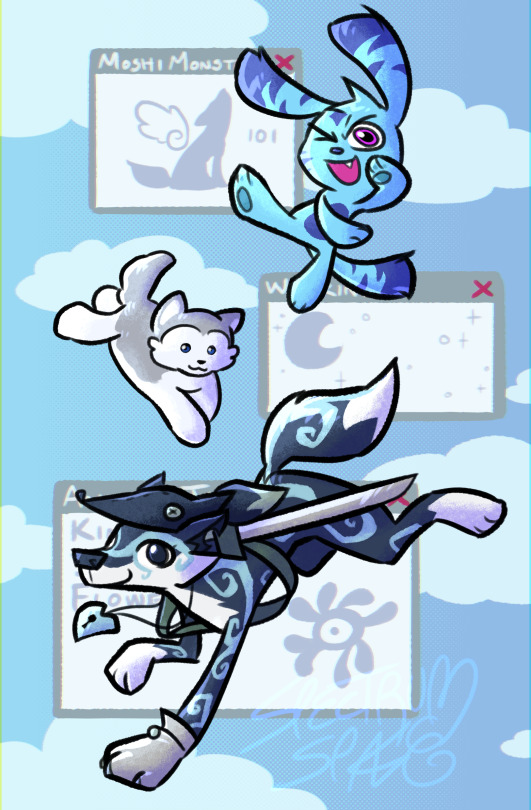#buffer animation
Explore tagged Tumblr posts
Text
Back before we stopped having Satellite TV and switched to streaming services, I have this vivid memory of a very specific Adult Swim buffer cartoon of this pixel art duo of heroes fighting this villain, and the male half of the duo literally penis blasts their opponent, as an attack. I only ever saw it once, and sometimes I think about it and how crazy it was, especially with the rise of the “penis blast” meme on Tumblr. I wish I could find it, but something tells me that searching “adult swim penis blast buffer” on YouTube isn’t going to get me anywhere.
30 notes
·
View notes
Text
Oh…. Well, it’s over for Crunchyroll I guess

#Crunchyroll#piracy#funimation#money hungry ass streaming service#rambling#I’ve never paid for a streaming service in my life thank god#I appreciated using others accounts but I personally cannot see myself paying this much for a service if I had the funds 😭!#get back to pirating kings!!!#anime has always been one of the easiest forms of media to pirate anyway so y’all got this#CR is definitely not worth paying for though#CR is certainly not worth paying this much for even if it’s a yearly one time fee#capitalism#the fact that CR has always had pretty bad quality as a streaming service anyway#it buffers every time you pause or rewind anything
88K notes
·
View notes
Text
also, I just got the edits back for the Sir Cameron book, and they're so interesting!! I feel almost ashamed, because they made me realize how blind I am to my own book? like I hope that I would pick up on all these flaws when reading someone else's work. anyways, very happy to have someone smart and knowledgeable picking it apart and giving me the chance to fix things before it goes out to the public. but I did also go into flight or fight mode in my living room out of sheer embarrassment.
#my editor is a very lovely and kind person#who buffered her feedback with many nice words#but I am a little fearful animal and it cannot be helped
1K notes
·
View notes
Text

{ Click/Tap for better quality. }
Follyyyy!!! 😊😊😊😊😊🥴💕💕💕💕💕💕 Been wanting to try making art gifs, here's a simple one. I used Capcut and Ezgif dot com.
Here's two still images of said gif!


#folly regretevator#regretevator folly#folly#regretevator#regretevator fanart#fan art#digital fanart#digital art#digital artist#gif#gif art#animated gif#artists on tumblr#tw eyestrain#eyestrain tw#eyestrain#tw eye contact#eye contact tw#eye contact#My ONLY regret of this is the beginning being a bit too long before the movement#To me at least#However I am still very happy this turned out well!#Also I think Folly cursed this artwork when I was working on it#Cause IbisPaint crashed and buffer like craaaazyyyy :[#Quote is from The Mysterious Stranger scene in Adventures of Marl Twain (though I removed the second 'and you')
648 notes
·
View notes
Text
Round 3 - Mammalia - Carnivora




(Sources - 1, 2, 3, 4)
Our next order of mammals is Carnivora, mammals specialized primarily in eating meat. A diverse order, Carnivora contains the living families Canidae (“dogs”), Ursidae (“bears”), Phocidae (“earless seals”), Otariidae (“eared seals”), Odobenidae (“Walrus”), Mephitidae (“skunks” and “stink badgers”), Ailuridae (“Red Panda”), Procyonidae (“raccoons”, “coatis”, “ringtails”, “kinkajous”, and kin), Mustelidae (“weasels”, “badgers”, “otters”, “Wolverine”, and kin), Nandiniidae (“African Palm Civet”), Viverridae (“civets”, “genets”, “Binturong”, and kin), Herpestidae (“mongooses”), Eupleridae (“Malagasy mongooses”), Hyaenidae (“hyenas”), Prionodontidae (“Asiatic linsangs”), and Felidae (“cats”).
As the sixth largest order of mammals, Carnivora is very diverse and exhibits a wide array of body plans, varying greatly in size and shape. They usually have large, conical, thick, stress-resistant canine teeth. Most species have eyes on the front of their face, pointing forward. They often have a very well-developed sense of smell. Some carnivorans have retractile or semi-retractile claws. Carnivora is separated into two suborders, Caniformia and Feliformia, with Caniforms containing canids and their relatives and Feliforms containing felids and their relatives. (Yes, even in taxonomy, there is a dichotomy between cats and dogs.) Caniforms have longer jaws and more teeth, with less specialized carnassial teeth. They also tend more towards omnivory and opportunistic feeding, while the feliforms, other than the viverrids, are more specialized for eating meat. Some carnivorans have secondarily evolved mainly herbivorous diets. They exist in almost every habitat, from the polar North to hyper-arid deserts to marine seas.
Male carnivorans are usually larger than females. Some species are social while others are solitary. Some species only meet to mate, some form family groups organized around a breeding pair, and some involve a single male or males leading a harem of females and their young. Carnivores usually invest a lot into their young, teaching and raising them to adulthood.
Carnivoramorpha as a whole first appeared in the Paleocene of North America about 60 million years ago, as small marten-like or civet-like predators of insects, lizards, and other small vertebrates. Feliforms and Caniforms split around the Middle Eocene, about 42 million years ago. The precursors to the living feliforms remained forest-dwelling, arboreal or semi-arboreal ambush hunters, while the caniform precursors were more mobile, opportunistic hunters.

Propaganda under the cut:
Canids tend to live as monogamous pairs. Wolves (Canis lupus), Coyotes (Canis latrans), African Wild Dogs (Lycaon pictus), and Dholes (Cuon alpinus) live in groups that include a breeding pair and their offspring. Wolves may even live in extended family groups. Living in family groups allows these animals to work together to take down prey larger than themselves.
The Domestic Dog (Canis familiaris) was the first species to be domesticated by humans, from the Wolf (Canis lupus), more than 30,000 ago when humans were still hunter-gatherers. Domestic Dogs have evolved alongside humans, adapting to better understand and communicate with us, read human body language and expressions, and smell human emotions. Both dogs and humans release oxytocin while spending quality time together, a sign of a strong social bond. Over 340 breeds of Domestic Dog have been selectively bred for tasks such as hunting, herding, pulling loads, detecting a variety of scents, protection, and companionship, with various breeds also filling roles in therapy, aiding disabled people, and assisting police and the military.
According to the Creation Myths of the Serer People, jackals were the first animals on Earth, and the first intelligent beings before humans, and will be the last. In some stories, the jackal is sent to Earth by Roog as a messenger, and in others as a fallen prophet for disobeying the laws of the divine. The movements of the jackal are carefully observed, because the animal is viewed as a seer who came from the transcendence and maintains links with it. Although believed to be rejected by the other animals and deprived of its original intelligence, it is still respected because it dared to resist the supreme being who still keeps it alive.
The Polar Bear (Ursus maritimus) is the largest land carnivore, with adult males weighing 300–800 kg (660–1,760 lb) and being 200–250 cm (6.6–8.2 ft) long. Females are smaller at 180–200 cm (5.9–6.6 ft) with a weight of 150–300 kg (330–660 lb). Adults may stand 130–160 cm (4.3–5.2 ft) tall at the shoulder. The largest Polar Bear on record, reportedly weighing 1,002 kg (2,209 lb), was a male shot at Kotzebue Sound in northwestern Alaska in 1960.
The word “panda” derives from the Nepali word “ponya”, which means “ball of the foot” and “claws”. The Nepali word for the endangered Red Panda (Ailurus fulgens) is "nigalya ponya", which has been translated as "bamboo-footed", due to the animal’s adapted wrist bone which allows it to grip bamboo. When the Red Panda was first described in 1825, it was named an English shortening of this name: “panda.” For more than 40 years the Red Panda was known as simply the panda: the one and only panda. However, when the vulnerable Giant Panda (Ailuropoda melanoleuca) was described in 1869, it was also given the name panda. Historically, there was much debate over the taxonomic positions of these two species, as they were both carnivorans that had adapted to a very specific diet of mostly bamboo. However, we know today that the Giant Panda is indeed a bear and not closely related to the Red Panda, which is the only living member of its own family.
The endangered Giant Otter (Pteronura brasiliensis) is a semi-aquatic predator of north-central South America, and is capable of bringing down animals as tough as a small caiman. Giant Otters live in extended family groups, and are highly social with each other, but extremely territorial of other groups. Battles between groups sometimes break out at the boundaries between territories.
Weasels (genus Mustela) have a behavior called the “weasel war dance”, which consists of a frenzied series of hops sideways and backwards, often accompanied by an arched back and a frizzed-out tail. The weasel war dance happens when the animal is excited or happy, and often occurs after they have caught or killed their prey, or are playing.
Ferrets (Mustela furo) were domesticated from the European Polecat (Mustela putorius) around 2,500 years ago. The Romans used ferrets to hunt rabbits, rodents, and moles, as they are specifically adapted to squeeze into holes after prey. Genghis Khan, ruler of the Mongol Empire, is recorded as using an army of ferrets in a gigantic hunt in 1221 that aimed to purge an entire region of wild animals.
The smallest carnivoran is the Least Weasel (Mustela nivalis). Average body length (not counting the tail) in males is 130 to 260 mm (5 to 10.2 in), while females average 114 to 204 mm (4.5 to 8 in). Males weigh 36 to 250 g (1.3 to 8.8 oz), while females weigh 29 to 117 g (1 to 4.1 oz). Despite their diminutive size, Least Weasels are still effective predators, and can take on prey up to the size of a rabbit.
The North American Black-footed Ferret (Mustela nigripes) declined throughout the 20th century, primarily as a result of declines of its main prey, Prairie Dogs (genus Cynomys). In 1979, it was declared extinct. However, a small wild population was discovered in Meeteetse, Wyoming in 1981! A captive breeding program was launched, using these ferrets, and a reintroduction campaign was put into play. Today, over 200 mature individuals are in the wild across 18 populations, with four self-sustaining populations in South Dakota, Arizona, and Wyoming. In 2008, the Black-footed Ferret’s IUCN status was changed from “extinct in the wild” to “endangered”. In February 2021, the first successful clone of a Black-footed Ferret, a female named Elizabeth Ann, was introduced to the public. She was cloned using frozen cells from Willa, a female Black-footed Ferret who died in the 1980s and had no living descendants. This exciting development opened the doors to a new option for introducing much-needed genetic diversity into the captive breeding population. Elizabeth Ann could not breed herself, due to a condition unrelated to the cloning process, but in 2024, two new Black-Footed Ferret clones, Noreen and Antonia, were also cloned from Willa’s frozen cells. Antonia has since birthed a male and female kit, and Noreen is waiting for a suitable match.
The Honey Badger (Mellivora capensis) is famous for its strength, ferocity, and toughness. It is known for being able to fearlessly fight back when cornered, sometimes even dissuading Lions (Panthera leo) and Spotted Hyenas (Crocuta crocuta) from attacking it. It often raids beehives in search of honey and larvae, and is unbothered by bee stings, which have trouble penetrating its thick skin. They have been observed to kill and eat Black Mambas (Dendroaspis polylepis). They are also highly intelligent, and have been observed manipulating tools and performing complex problem-solving. Despite all this, they are only dangerous to humans if provoked, and most of their reputation comes from their willingness to defend themselves.
There are three species of raccoon, and the small, critically endangered Cozumel Raccoon (Procyon pygmaeus) is the rarest of them. It is native only to Cozumel Island off the coast of the Yucatan Peninsula, Mexico. It is estimated there are only around 192 mature individuals left in the world.
Walruses (Odobenus rosmarus) have powerful, mobile lips that they can use to generate high-powered suction. They do this to feed on one of their favorite prey items: clams. A Walrus can suck the meat out of a clam by sealing its powerful lips to the animal’s shell and withdrawing its piston-like tongue rapidly into its mouth, creating a vacuum. They can also use their mobile lips to whistle in the same way humans do!
The Baikal Seal (Pusa sibirica) is the only species of exclusively freshwater seal. They are native only to Lake Baikal in Siberia, Russia. The most recognizable characteristic of the Baikal Seal is its large, dark eyes. Lake Baikal is the deepest lake in the world, and has varying levels of light intensity. The seal’s large eyes allow it to take in as much light as possible in this environment.
The African Palm Civet (Nandinia binotata) is the most genetically isolated Carnivoran, being the only species within its whole superfamily.
The Jaguar (Panthera onca) employs an unusual killing method: it bites directly through the skull of mammalian prey, between the ears, to deliver a fatal blow to the brain. It does this with a powerful bite force of 1,500 PSI. This bite also allows it to pierce the shells of turtles and the osteoderms of caimans.
When Cecil the male African Lion (Panthera leo leo) was killed in July 2015 by Walter Palmer, an American recreational big-game trophy hunter, there was international uproar and a change in the atmosphere regarding trophy hunting. There was also worry amongst the scientists who had been studying Cecil’s pride that his cubs were now in danger. When one or more new male Lions replace a previous male(s) associated with a pride, they often kill any existing young cubs, to ensure that only their bloodline is produced going forward. However, Cecil had formed a partnership with another male lion named Jericho. When Cecil was killed, Jericho took over the pride but did not kill Cecil’s cubs, and also protected them from any rivals.
The Domestic Cat (Felis catus) was domesticated from the African Wildcat (Felis lybica) about 10,000 years ago. Ancient Egyptians revered the Domestic Cat, and families would take their dead cats to the sacred city of Bubastis, where they were embalmed and buried in sacred repositories. Cats eventually replaced Ferrets as the pest-controlling housepet of choice in Ancient Greece and Rome, as they were considered more pleasant to keep around the house. Like dogs, they have adapted to live alongside us, evolving new vocalizations, body language, and behaviors specifically for communicating with humans, and generally becoming a social species (the African Wildcat is typically solitary and territorial). Today, there are over 41 breeds of Domestic Cat, and they are kept mainly for companionship and pest control. Unfortunately, they have also become one of the most abandoned pets.
The Cheetah (Acinonyx jubatus) is regarded as the fastest-running land animal. It is capable of running at 93 to 104 km/h (58 to 65 mph) in a sprint.
The Asian Palm Civet (Paradoxurus hermaphroditus) is threatened by poaching and the illegal wildlife trade in Indonesia. They are captured for use in the production of kopi luwak. Kopi luwak, also known as civet coffee, is a coffee that consists of partially digested coffee cherries, which have been eaten and defecated by the Asian Palm Civet. The cherries are fermented as they pass through a civet's intestines, and after being defecated with other fecal matter, they are collected. What was once a traditional drink, made from coffee cherries collected from civet feces in the wild, has become increasingly commercialized due to international demand and curiosity. Now, to meet demand, Asian Palm Civets are captured, kept in battery cages, and forcefed nothing but coffee cherries. The civets in kopi luwak farms are kept in abysmal conditions which include isolation, poor diet, small cages, and a high mortality rate. Kopi luwak is one of the most expensive coffees in the world, with retail prices reaching US$100 per kilogram (2.2 lbs) for farmed beans and US$1,300 per kilogram for wild-collected beans.
In some countries, the African Civet (Civettictis civetta) (image 4) is threatened by capture for the perfume industry, as its pheromone civetone is often used as a natural musk. The Calvin Klein-brand male cologne Obsession utilizes synthetic civetone, making the cologne highly attractive to feliforms. Obsession is sometimes used in the field to attract wild cats to camera traps, and is also used in zoos and sanctuaries as scent enrichment.
Mongooses (family Herpestidae) are one of at least four known mammalian taxa with mutations in the nicotinic acetylcholine receptor that protect against snake venom. This makes them fierce and effective predators of venomous snakes.
The Spotted Hyena (Crocuta crocuta) lives in large clans which can consist of up to 80 individuals. These clans are typically led by females, though they can occasionally co-dominate with a male. Clans are run by a matriarch, and her youngest female cub will become the new matriarch when she passes. When a male co-dominates with a female or is otherwise able to lead, this is because the male was born to the matriarch of the clan and has taken the rank directly below his mother.
The Aardwolf (Proteles cristatus) is a small, basal hyena that mainly eats termites. Like other animals adapted for eating termites, it has a long, sticky tongue.
Carnivorans usually occupy a very important part of the ecosystem, and most apex predators are carnivorans. Apex predators can be considered ecosystem engineers, due to the huge impact they have on their environment. One of the most famous examples of this was the reintroduction of Wolves (Canis lupus) in Yellowstone National Park. In 1884, the state of Montana instituted a bounty on Wolves: one dollar per Wolf killed. Wolves were considered a “menace” to Yellowstone’s wildlife, and more concerted efforts mounted to exterminate them. The Elk (Cervus canadensis) population began to explode, and they grazed their way across the landscape, killing young brush and trees. As early as the 1930s, scientists were alarmed by the degradation and were worried about erosion and plants dying off. By the 1970s, there were no resident populations of Wolves in Yellowstone, and Wolves had been almost completely eradicated in the lower 48 states. In 1974, the Wolf was listed in the endangered species act.
Starting in January 1995, Wolves from Canada began to be relocated to Yellowstone National Park. In the years that followed, wolves brought the Elk population down and their presence protected the open valleys from overgrazing, as the fear of predators kept the herds on the move. Willows (genus Salix) began to grow larger, with an increase in size of 1,500% by 2020. With the foliage returning to the park, Beavers (Castor canadensis), Lynxes (Felis lynx canadensis), Wolverines (Gulo gulo) (image 1), and many other formerly reduced species began to rebound. Beaver colonies have grown from 1 in 1995 to 19 by 2015 with four active dams in use. The dams build wetland ecosystems, used by millions of other species. This is an enduring example of a Trophic Cascade: a powerful indirect interaction that can control entire ecosystems, occurring when a trophic level in a food web is removed or added.
Even though domestic carnivorans like the Domestic Dog, Domestic Cat, and to a lesser extent, the Ferret, are some of the most popular pets in the world, most wild carnivorans have been, and still are, unfairly demonized. Many species have been overhunted, resulting in extirpation in some areas. Even early “conservationists” did not understand the value of predators, considering it a boon to the ecosystem to wipe them out entirely. Bounties are still placed on carnivorans today, and many ranchers and farmers push to have them completely wiped out to protect their livestock. If you cross the border of Yellowstone into a nearby town, you must be ready to hear all about how Wolves are evil creatures who kill for pleasure, and are going to kill all the precious Elk. It is a constant uphill battle to reintroduce carnivorans who may have been extirpated from their historical ranges. Yet in some places, humans have learned to coexist with these important parts of the ecosystem. One of the best ways to support carnivorans is through ecotourism. Locals tend to see more value in the predators they have to share space with when visitors are both excited about and bringing in tourism revenue because of these animals.
#animal polls#round 3#mammalia#I didn’t mean to post this early for some reason the schedule turned into a post now button when I went to edit it#but here we are#my buffer has finally caught up to me and here I am writing about carnivorans at 3am when I have to get up in 3 hours and drive for 12#rip me#sorry there’s not more fun animals facts
156 notes
·
View notes
Text




(Body type hcs)
sticks but in shapes other than sticks
#this was mainly just me getting a feel for how I wanted to draw their body types#I made sec buffer than i initially wanted but i kinda like it#spreading my short king chubby victim propaganda#also fat chosen propaganda#lil note: it’s not visible heee but victim DOES have a tail like the other hollowheads#it’s just really really short#the gang was super fun to do tbh I love them#my art#alan becker#animation vs minecraft#animator vs animation#animation vs animator#ava tco#ava tdl#ava green#ava red#ava blue#ava yellow#ava tsc#ava victim#ava purple
240 notes
·
View notes
Text
the choice to put Senshi's horrific backstory AND him getting turned into a romance-novelesque hot skinny elf in the same episode is so impeccable i think this show might be the best ever
#veesaysthings#dungeon meshi spoilers#dungeon meshi#senshi#literally dunmesh has the best tragic/comedic balance of all time#like obviously in the manga these stories do follow each other. but also in the manga the changeling chapter starts off a new volume.#so there's wayy more buffer than in the anime lmao
184 notes
·
View notes
Text

Cringetober Day 25: Gacha Life Kids' Games
not familiar with Gacha Life, tried to approach the prompt more generally!! everyone has their "posting low-quality footage of a game to youtube at an age far too young for youtube" phase. solidarity.
#cool ada art tag#cringetober 2024#webkinz#animal jam#moshi monsters#//hwehhh i feel kinda bad with the prompts where i blow it off too much#//gacha life isnt bad and there are cool fun adult cartoons out there!! im just lazy#//well. i'm busy too. i can't afford to get into something new just for a drawing#//do you know this is probably the closest i have done to organically doing a month-long art challenge#//i decided to join cringetober on like september 30th i had no time to draw a buffer in advance#//the candy gore pic was LATE!!#//i am at best like two days ahead at a time
83 notes
·
View notes
Text
Had I Not Seen the Sun from Had I Not Seen the Sun Chevy, Ruby Qu, Eli.W, HOYO-MiX
#hsr#honkai star rail#had i not seen the sun#robin#chevy#eli.w#penacony#vocal track#cutscenes#trailblaze mission#trailblaze:penacony#plays in animated cutscene in 'a thousand bells at dawn' in the penacony trailblaze mission 'farewall penacony' chapter#needed 7 second buffer at beginning#hsr:vocal track#ruby qu
59 notes
·
View notes
Text



Anya / Spy × Family Code: White (2023)
#anya forger#anime eyes#spy x family#spy x family code white#i watched the first 8 minutes#then my network collapsed and landed me in buffering hell#i might not go back to finish it#so please enjoy these screenshots of anya#waku waku
35 notes
·
View notes
Text

AUUUU STOP THIS MOMENT WAS ADORABLE AND SWEET AND PRECIOUS AND MY HEART MELTED FOR THEMMMMM 😭💕
(lots of writing under the ‘read more’ btw incase you want my personal thoughts on things!)
Before the episode started I has been bracing myself for the genocide route, but it seem like what we ended up getting was the pacifist route because NEVER would I have anticipated such an empathetic twist??? I was dead convinced that my hopes/dreams of Puzzle redemption were squandered and left to rot (they probably still are to some degree actually lol but oh well I can accept that he’s a lovable psycho). And yet this episode does the impossible….giving us an unfathomably wholesome scene that helps heal his dejected inner child, even just a little. PLEASE this wasn’t something I was prepared for and it’s gotten such a strong grip on my heartstrings right now. I love themmmmm holy shittttt <33
I didn’t think Meggy would step up and try to connect with him like that especially since she was so aggressively defensive when he initially reached out. And I like that even when she gets to speak to Little/Kid Puzzles her behavior is very stern at first lol. Kinda like a disappointed older sister who can’t be bothered to put up with him for too long. But using Leggy as a way to build that bridge again was so clever of her—and hey it helped lure him into false sense of security so he’d get jailed up jskjsksp. Everyone wins I guess!! ALSO can I just say whoever composed the soundtrack (Zach Preciado for the rap segment specifically) deserves just as much praise as the voice actors because DAYM the layering of all those instruments and the seamless transitions into different emotional tones was superb :))
#SHUT UP I’M NOT SOBBING MY EYES OUT YOU ARE DON’T LOOK AT ME RIGHT NOW /j#naw kidding I don���t cry easily#although it did make me say ‘awwh’ multiple times out loud and do squeaky happy noises#THIS EPISODE WAS WORTH THE WAITING YEAAAA#although I will say think we kinda buffered severally on the intended tone of what to expect from it#like I think the fandom collectively figured it would be intense and darker themes#probably more edgy and characters actually screaming in pain or fear#kinda leaning into a Jigsaw horror movie#but this was far more light compared to any of that soooooo jksjsksp#if anyone starts labeling this episode as ‘not good’ maybe consider your own personal biases beforehand yea?#don’t get me wrong I do believe there’s valid concerns over how Puzzle’s character will be handled going forward#given how he’s not dead (THANK THE LORD ABOVE MY BOY LIVESSSSS)#and yea guess it was missing a bit more emotional weight when it came to the threat levels#BUT the Kid Puzzles & Leggy scene made up for any of those gripes in my opinion <33#HOW COULD ANYONE HATE THESE TWO LOVABLE PEEPS I WANNA HUG THEM TOOO#okay now back to animating for the MAP project :))#hplonesome art#WOTFI 2024 spoilers#spoilers WOTFI 2024#wotfi 2024#smg4 WOTFI spoilers#smg4 wotfi 2024#little mr puzzles#leggy & little mr puzzles#little mr puzzles & leggy
52 notes
·
View notes
Text
please read undead unluck because it has not one but two distinct times where a female character dramatically takes off her top layer of clothing to reveal she is actually fucking shredded and yes it does kick so much ass every fucking time
#and not anime girl shredded either#actually genuinely ripped#undead unluck#also i guess if you count Mui's appearance in this new arc you could make a case for three times#she's much buffer this loop than last time
242 notes
·
View notes
Text


58 notes
·
View notes
Text
watching murder drones on youtube vanced makes me feel bad about using youtube vanced
#xenon screams#murder drones#just finished episode six#sHE DIED???????#WHAT THE FUCK??????????????????????????????????????????????????????????#i just tapped the ? so hard that my cat woke up#but like holy fuck#this animation is fucking STELLAR#ok she fell back asleep#(my cat)#(not v)#(v is very dead probably)#(unless she isn't)#anyway#im a 3d animator and im watching this going ''what the fuuuuuuck'' the whole time#maybe bc ive only ever used mmd#but still. i need to put this in my mouth#also they buffer??#i was under the impression they were robotesque living beings?#which sounds stupid#but they have saliva and sweat and (presumably) give birth#i was planning on watching it and then going to sleep but I can't sleep now#what the hell am i supposed to do. i finished my schoolwork for the week. i have nothing to do
4 notes
·
View notes
Text
truly so many games that i wish i could just turn on like. 'my reaction time is dogshit please slow everything down by 0.25 seconds thanks' mode for
#pers#currently failing at fishing in animal crossing hkjgdasg. but i do think about this with a LOT of games i play#like i just need that buffer time to be a tiiiiiny bit longer and my life would be so much easier
10 notes
·
View notes
Note
hi! Could we have a headmate with the role “trauma buffer” (a part that consciously or subconsciously blocks other parts from discovering trauma, without being aware of said trauma in one way or another)
Based off these emojis with a couple add ons please!
🐕🦺🪽🌾🪐🍗🐺📺⚰️
[Brought to you by: Mods Chem and Perzoreth!]
🐺 HEADMATE TEMPLATE 🪽
✦ Name(s): Viriel, Giriah, Evrius ✦ Pronouns: he/him, it/its, they/them, wing/wings/wingself, howl/howls/howlself, star/stars/starself, vi/vir/virs/virself, e/em/eir/eirs/emself ✦ Species: wolf anthro angel ✦ Age: ageless adult ✦ Role(s): trauma buffer, gatekeeper, syspet, optimist, faunin, comforter, destressor, protector ✦ Labels: veldian, daroric, comfic, demiguy ✦ Xenos: death, food, space ✦ Likes: cemeteries, farm animals, soft things ✦ Dislikes: being inside for too long ✦ Music taste: indie rock, classic rock, darkwave ✦ Aesthetic(s): dark naturalism, analog horror aesthetic, angelcore ✦ Objectum attraction(s): televisions ✦ Kins: ringed planets, cows, sparrows ✦ Interests: black and white films, astronomy ✦ Hobbies: stargazing, cooking ✦ Emoji proxy: 🐺🪽 ✦ Details:
Viriel is an angelic wolf who acts as a trauma buffer and an emotional support animal to its system. It is friendly, caring, and protective, and it fronts with the system during stressful situations. They have a good sense of humor and enjoy sharing jokes with the system's friends. They consider themself a service animal for the system due to how they protect headmates from trauma.
✦ Role performance:
Viriel is in a system whose amnesiac barriers mean that not every headmate has full knowledge of everything that has ever happened to the system. Viriel is not aware of all the system's trauma, but he knows who the holders for it are. When those headmates are fronting around headmates who aren't supposed to know about that trauma and Viriel can tell the trauma holder is close to doing something that would reveal the trauma, he flaps his wings, creating a gust of white sparkling dust that flies towards the trauma holder, covers them, and removes them from front.
✦ Personality:
Viriel is silly and whimsical, but they also have a dark streak. They are very aware of death and the terrible things that happen in life, but they try to look for the positives anyway. They often engage in canine behaviors, both as a matter of their species, to comfort the system, and to destress.
[These can be edited and changed as needed, and headmates will almost definitely not turn out EXACTLY as described.]
#templatepost#alter packs#headmate packs#build an alter#build a headmate#create an alter#create a headmate#alter creation#headmate creation#source: request#adult themes: no#species: non human#age: ageless#age: adult#roles: trauma buffer#roles: trauma manager#roles: gatekeeper#roles: syspet#roles: optimist#roles: faunin#roles: comforter#roles: destressor#roles: protector#themes: animals#themes: angels#themes: trauma
2 notes
·
View notes